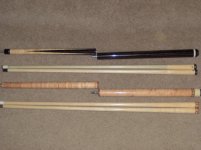Cue Construction
For transmitting power, cue construction is the key. The tip is the most important thing, next is the ferule. This is where a real catch comes in to breaking with a house cue, most have soft ferules. The shaft is the next consideration. Both material and design come into play here. Using a parabolic taper and a slightly faster taper in the "pro" section will make the shaft much stiffer regardless of how the blank is made. I suspect the folks at OB are working on something along those lines. I have to say that low deflection doesn't matter if you hit the cue ball square however hitting it square every time is an issue for most people so a decision might have to be made there.
Moving on in cue construction, the joint is next in level of importance. Diameter, contact surface, and material all matter as does which pin is used. The butt is a gray area, the fore arm definitely matters, the handle and grip comes into play also but I do not know to what degree.
Assuming a hard tip will be used, shaft and ferule are of the most importance and most cues will be a respectable break cue if you have a break shaft made for it. Proving the importance of the things behind the shaft, I tried making a break shaft for a Budweiser sneaky that I had changed the joint collars out to phenolic on and replaced the pin with a quality stainless 5/16" pin after coring the fore arm a ways and inserting a maple dowel to allow me to center the pin. This was starting with one of the throw away Budweiser cues. It still did not break as well as a house cue. I think a new wrap would help somewhat as the wrap on this cue was pretty loose. However I don't think the skinny joint and fore arm are going to allow this to be a decent break cue no matter what else I do.
This is a long winded way to explain, if you are going to get a cue to break with, get one that is designed end to end to be a break cue. You might as well gain all of the advantages that you can. For a home break cue or if I had a place to keep one at a pool hall I might be very happy with a house cue to break with, changing only the tip and ferule. The design isn't perfect for breaking but probably better than the average two piece cue.
Hu



